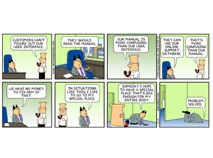 Editor’s note: Guest author Aaron Levie is the founder and CEO of Box.net
Editor’s note: Guest author Aaron Levie is the founder and CEO of Box.net
Thomas Wailgum, an editor at CIO.com, summed up the enterprise software industry best when he wrote, “It might appear that even tobacco companies enjoy a better level of overall ‘likeability’ than do enterprise software vendors.”
The way successful enterprise software companies have historically operated has been more or less uncontested: licensing costs increase at regular intervals, technology is difficult to integrate, and the user experience is often atrocious. Unlike most other open markets, which force out negative behaviors over time, many of the practices in place today serve the vendor and customer asymmetrically. Amazingly, more than 40% of IT projects still fail to deliver the expected business ROI, yet enterprise vendors come out winning regardless.
But not for long. Now that enterprise software can be delivered over the web and iterated quickly, we’re seeing the barriers for development, distribution and adoption shrink to levels previously only witnessed by consumer internet companies, with millions of users on top of platforms like Yammer, Box, and Zendesk; these changes are creating a much more competitive landscape where the customer stands to gain tremendously. The values that now separate legacy vendors from a new breed of companies are not only technological, but also cultural and organizational. In short, building better enterprise technology requires that we build fundamentally different enterprise technology companies.
Creating amazing products, not amazing RFP responses
Enterprise software vendors have long enjoyed a counterintuitive, but highly lucrative, reward system. Its buyers are different from the ultimate users, and each group’s needs are radically different — traditionally, enterprise technology has been designed with the sale to the CIO in mind, and this produces solutions that are inevitably feature-bloated to “satisfy” the vast majority of a customer’s requirements.
This has created an oddly perverse dynamic where the vendors with the most feature-rich solutions win the contracts, but the users lose due to the complexity of the technology. And thanks to the incredibly long gaps between product releases, vendors are further motivated to cram as many features as possible into each version, hoping to check all the boxes on RFPs for the next few years.
So how do new entrants avoid this cycle all together? By focusing on building enterprise software that the users love, driving demand up to the CIO. Vendors like Workday, Jive, Yammer, or Rypple are responding by investing more in design, usability, openness, and the total user experience. They’re measuring success by user adoption, rather than feature checklists. And thankfully, buyers are catching on.
At Box, we now see RFPs where “user adoption” is a heavily weighted factor in the purchasing decision; this was virtually unheard of a few years ago. IT managers are realizing that there are better, more strategic uses of their time than training employees, fighting low adoption, and contending with angry users – they want technology that just works. And because of this, we’re seeing more alignment between users and the CIO than ever before.

Maintaining a hacker-centric engineering culture
Paul Graham wrote a great essay last year on the need for hacker-centric cultures, where he ostensibly attributed Yahoo’s decline to their failure to build an engineering-driven organization. Enterprise software companies are uniquely vulnerable to the tendency of losing their edge in this way. For many enterprise software startups, survival mode kicks in and the market forces them to trade their product vision for more immediate, realistic revenue opportunities. But roadmaps driven by the goal of winning bake-offs or a few exceptional clients are the quickest way to kill the engineering spirit in your organization and turn away strong talent.
Today, the size and scope of the markets that even the tiniest enterprise startup can go after, and the amount of data and tools at their fingertips, are unprecedented. And because new software entrants are moving at web-speed, the challenges and rewards of building for the enterprise are drawing a new crop of developers. We speak with prospective engineers that hold the latest group of enterprise software startups, like Asana or PBworks, in the same regard as Facebook or Zynga because the ethos are now remarkably similar (minus the farm animals).
When business applications are delivered over the web, releases often occur on a weekly (or daily) basis – far from the standard three year cycle experienced by those working for Microsoft and most incumbent enterprise software companies. Engineers get to see their projects come to life immediately, and the organization benefits from instant product feedback.
Try performing A/B tests on a Siebel system or Lotus 10 to 15 years ago, or pulling customer activity in real-time to drive product decisions. It simply wasn’t possible. Or, just imagine what enterprise software would look like if all enterprise vendors implemented Google’s 20% time, or quarterly hackathons?.
Building radically different enterprise sales
The new approach to building and delivering enterprise software also entails a very different sales process. With web-delivered, freemium or open source solutions, we’re seeing viral, bottom-up adoption of technology across organizations of all sizes. And while the ultimate buyer remains the same (as Ben Horowitz has pointed out), the chief adopters of technology are now the individuals within an organization looking for quick, easy ways to solve their most pressing business problems. With the freemium model in particular, software companies now have an incredibly scalable and qualified lead generation vehicle; your sales team doesn’t have to bang on the doors of unsuspecting and uninterested buyers, because your prospects are already familiar, and likely successful, with your product.
This is also changing enterprise software buying patterns. Enterprises are tired of six to twelve month sales cycles that leave them with a solution that ultimately fails to gain traction. They’re beginning to focus on working with technology that their employees are already using or familiar with. This model forces the sales organization to stay honest, as customers generally have to be “bought” into the product before they’ve technically paid anything.
Consequently, enterprise sales tactics and techniques reminiscent of Alec Baldwin in Glengarry Glen Ross are becoming as quaint as the mainframe. The sales organization isn’t going anywhere, it’s just focused on ensuring that customers are blown away by its products; and the focus is on building a department that is knowledgeable, consultative and friendly, focused on helping the customer navigate from being an early adopter to large scale

Taking responsibility for customer success and support
Finally, the enterprise software industry has become too wedded to a model where the success of the vendor is disconnected from customer success. Traditionally, as soon as an enterprise software sale is made, it becomes the buyer’s responsibility to support the purchase – often requiring the manpower of a 6 and 7-figure consulting engagement. For instance, Microsoft touts that nearly 80% of SharePoint deployments involve a partner in some capacity, and there’s a 6:1 ratio of dollars spent on services to the cost of the original licenses. While that’s great for the partner ecosystem, it means customers have no predictability in what they’ll ultimately be paying.
This too is changing. With the new wave of enterprise software companies, customers are no longer solely financially responsible for the victorious implementation of their purchased solutions. The unstoppable trend toward “renting” vs. “buying” software, means the vendor gets paid only as the software continues to solve problems for its customer. As forcing functions go, this is a pretty good one to ensure customers are happy — and it means implementation services, constant feedback loops, and deep customer engagement are all critical to successful retention.
And while we’re at it, customers should no longer have to pay dearly for vendor support. What if every enterprise technology company demonstrated a Zappos-like devotion to customer satisfaction? We’re already seeing this today with Rackspace eeking out extra margin with their fanatical support mantra. In the next generation enterprise software company, the customer support and services organizations are more important than ever before – committed to the success of customers throughout the entire life of product ownership.
The new rules of enterprise software are about delivering substantially better products and services, and aligning customers with buyers in unprecedented ways. We’ve already seen how quickly new solutions that are customer-focused can emerge within big and small businesses alike: Salesforce.com built an $20B market-cap company in a little over a decade with incredible customer success and satisfaction. The emergence of new enterprise platforms, and the amount of investment in and demand for these new tools, are going to dramatically change the competitive landscape for software providers. Startups, and even larger companies, that play by the new rules and understand the change taking place, will succeed. Ultimately, though, it’s customers that are the biggest winners, and my god has it taken a while for customers to win when it comes to their IT purchases.
































Comment